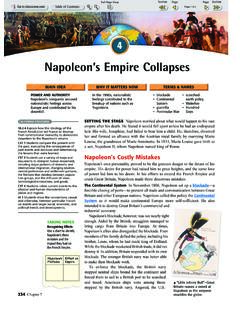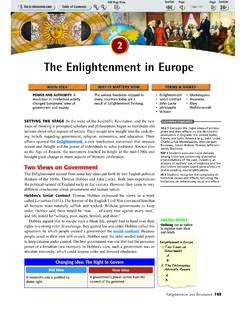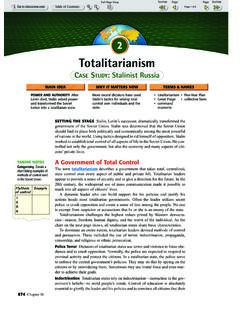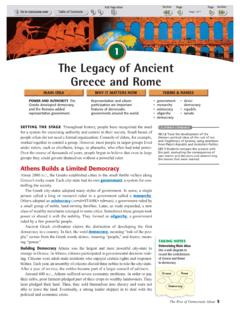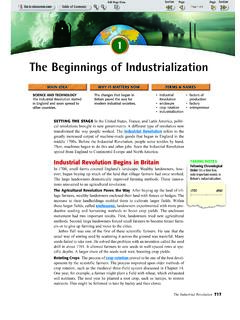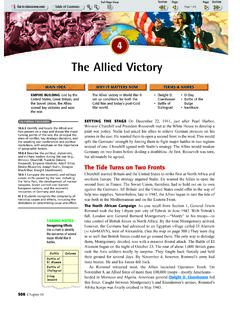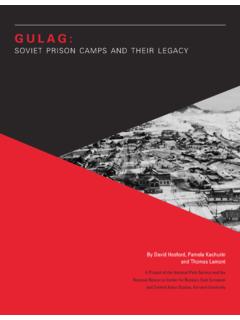Transcription of Europe Plunges into War - History With Mr. Green
1 The Great War411 MAIN IDEAWHY IT MATTERS NOWTERMS & NAMESSCIENCE AND TECHNOLOGYOne European nation afteranother was drawn into a largeand industrialized war thatresulted in many casualties. Much of the technology ofmodern warfare, such as fighterplanes and tanks, wasintroduced in World War I. CentralPowers Allies WesternFront SchlieffenPlan trenchwarfare EasternFront2 SETTING THE STAGEBy 1914, Europe was divided into two rival alliance, the Triple Entente, included Great Britain, France, and Russia. Theother, known as the Triple Alliance, included Germany, Austria-Hungary, andItaly. Austria-Hungary s declaration of war against Serbia set off a chain reactionwithin the alliance system. The countries of Europe followed through on theirpledges to support one another. As a result, nearly all of Europe soon joined whatwould be the largest, most destructive war the world had yet Great War BeginsIn response to Austria s declaration of war, Russia, Serbia s ally, began movingits army toward the Russian-Austrian border.
2 Expecting Germany to join Austria,Russia also mobilized along the German border. To Germany, Russia s mobi-lization amounted to a declaration of war. On August 1, the German governmentdeclared war on looked to its ally France for help. Germany, however, did not even waitfor France to react. Two days after declaring war on Russia, Germany alsodeclared war on France. Soon afterward, Great Britain declared war on of Europe was now locked in Take SidesBy mid-August 1914, the battle lines were clearly one side were Germany and Austria-Hungary. They were known as theCentral Powersbecause of their location in the heart of Europe . Bulgaria andthe Ottoman Empire would later join the Central Powers in the hopes of regain-ing lost the other side were Great Britain, France, and Russia. Together, they wereknown as the Allied Powers or the Allies.
3 Japan joined the Allies within joined later. Italy had been a member of the Triple Alliance with Germanyand Austria-Hungary. However, the Italians joined the other side after accusingtheir former partners of unjustly starting the war. In the late summer of 1914, millions of soldiers marched happily off to battle,convinced that the war would be short. Only a few people foresaw the horrorahead. One of them was Britain s foreign minister, Sir Edward Grey. Staring outover London at nightfall, Grey said sadly to a friend, The lamps are going outall over Europe . We shall not see them lit again in our lifetime. Europe Plunges into WarOutliningUse an outlineto organize main ideasand NOTESI. The Great War Begins A. A Bloody StalemateCALIFORNIA the principal theaters ofbattle, major turning points, and the impor-tance of geographic factors in militarydecisions and outcomes ( , topography,waterways, distance, climate).
4 CST 2 Students analyze how change hap-pens at different rates at different times;understand that some aspects can changewhile others remain the same; and under-stand that change is complicated and affectsnot only technology and politics but alsovalues and 3 Students use a variety of maps anddocuments to interpret human movement,including major patterns of domestic andinternational migration, changing environ-mental preferences and settlement patterns,the frictions that develop between popula-tion groups, and the diffusion of ideas,technological innovations, and 4 Students understand the meaning,implication, and impact of historical eventsand recognize that events could havetaken other directions. 412 Chapter 13A Bloody Stalemate It did not take long for Sir Edward Grey s prediction to ring true. As the summerof 1914 turned to fall, the war turned into a long and bloody stalemate, or dead-lock, along the battlefields of France.
5 This deadlocked region in northern Francebecame known as the Western Conflict Grinds AlongFacing a war on two fronts, Germany had developeda battle strategy known as the Schlieffen Plan, named after its designer, GeneralAlfred Graf von Schlieffen (SHLEE fuhn). The plan called for attacking anddefeating France in the west and then rushing east to fight Russia. The Germansfelt they could carry out such a plan because Russia lagged behind the rest ofEurope in its railroad system and thus would take longer to supply its front , speed was vital to the Schlieffen Plan. German leaders knew theyneeded to win a quick victory over on, it appeared that Germany would do just that. By early September,German forces had swept into France and reached the outskirts of Paris. A majorGerman victory appeared just days away. On September 5, however, the Alliesregrouped and attacked the Germans northeast of Paris, in the valley of the MarneRiver.
6 Every available soldier was hurled into the struggle. When reinforcementswere needed, more than 600 taxicabs rushed soldiers from Paris to the front. Afterfour days of fighting, the German generals gave the order to retreat. Although it was only the first major clash on the Western Front, the First Battleof the Marne was perhaps the single most important event of the war. The defeat0 8 E16 E24 E32 E8 W50 N42 NATLANTICOCEANN orthSeaBalticSeaBlack BRITAINAUSTRIA-HUNGARYGERMANYEAST PRUSSIABELGIUMFRANCEOTTOMAN , Nov. 19141st Marne, Sept. 19142nd Marne, July 1918 Verdun,Feb. 1916 Tannenberg,Aug. 1914 Galicia,May 1915 Limanowa,Dec. 1914 Lodz,Nov. 1914 Czernowitz, June 1916 Gallipoli, Feb. 1915 Jan. 1916 Kovel, June 1916 Kerensky Offensive,July 1917 Masurian Lakes,Sep. 1914 Caporetto,Oct. 1917 Somme, July 1916 Amiens, Aug. 1918 ViennaDec., 1917191819161916191819141914191619161917 TreatyofBrest-LitovskMarch,19180 400 Miles 0 800 Kilometers Allied countriesCentral PowersNeutral countriesFarthest Central PowersadvanceCentral Powers victoryAllied victoryCentral Powers advanceFarthest Allied advanceAllied advanceArmistice Line, Nov.
7 1918 World War I in Europe , 1914 1918 GEOGRAPHY SKILLBUILDER: Interpreting which country was almost all of the war in the West fought? geographic disadvantage did Germany and Austria-Hungary face in fightingthe war? How might this have affected their war strategy?of the Germans left the Schlieffen Plan in ruins. A quick victory in the west nolonger seemed possible. In the east, Russian forces had already invaded was going to have to fight a long war on two fronts. Realizing this, theGerman high command sent thousands of troops from France to aid its forces inthe east. Meanwhile, the war on the Western Front settled into a stalemate. War in the TrenchesBy early 1915, opposing armies on the Western Front haddug miles of parallel trenches to protect themselves from enemy fire. This set thestage for what became known as trench warfare. In this type of warfare, soldiersfought each other from trenches.
8 And armies traded huge losses of human life forpitifully small land in the trenches was pure misery. The men slept in mud, washed in mud,ate mud, and dreamed mud, wrote one soldier. The trenches swarmed with food was nonexistent. Sleep was nearly impossible. The space between the opposing trenches won the grim name no man s land. When the officers ordered an attack, their men went over the top of their trenchesinto this bombed-out landscape. There, they usually met murderous rounds ofmachine-gun fire. Staying put, however, did not ensure one s safety. Artillery firebrought death right into the trenches. Shells of all calibers kept raining on our sec-tor, wrote one French soldier. The trenches disappeared, filled with earth .. theair was unbreathable. Our blinded, wounded, crawling, and shouting soldiers keptfalling on top of us and died splashing us with blood.
9 It was living hell. The Western Front had become a terrain of death. It stretched nearly 500 milesfrom the North Sea to the Swiss border. A British officer described it in a letter: PRIMARY SOURCEI magine a broad belt, ten miles or so in width, stretching from the Channel to theGerman frontier near Basle, which is positively littered with the bodies of men andscarified with their rude graves; in which farms, villages and cottages are shapelessheaps of blackened masonry; in which fields, roads and trees are pitted and torn andtwisted by shells and disfigured by dead horses, cattle, sheep and goats, scattered inevery attitude of repulsive distortion and FLEMING, quoted in The First World War413 RecognizingEffectsWhy was theBattle of the Marneso significant? Allied troopscrawl through atrench along theWestern 13 VocabularyIn war, a casualtyis anyone killed,injured, captured, or considered missing in strategists were at a loss.
10 New tools of war machine guns, poisongas, armored tanks, larger artillery had not delivered the fast-moving war they had expected. All this new technology did was kill greater numbers of peoplemore effectively. The slaughter reached a peak in 1916. In February, the Germans launched amassive attack against the French near Verdun. Each side lost more than 300,000men. In July, the British army tried to relieve the pressure on the French. Britishforces attacked the Germans northwest of Verdun, in the valley of the SommeRiver. In the first day of battle alone, more than 20,000 British soldiers were the time the Battle of the Somme ended in November, each side had sufferedmore than half a million did the warring sides gain? Near Verdun, the Germans advanced aboutfour miles. In the Somme valley, the British gained about five Battle on the Eastern FrontEven as the war on the Western Front claimed thousands of lives, both sides weresending millions more men to fight on the Eastern Front.

